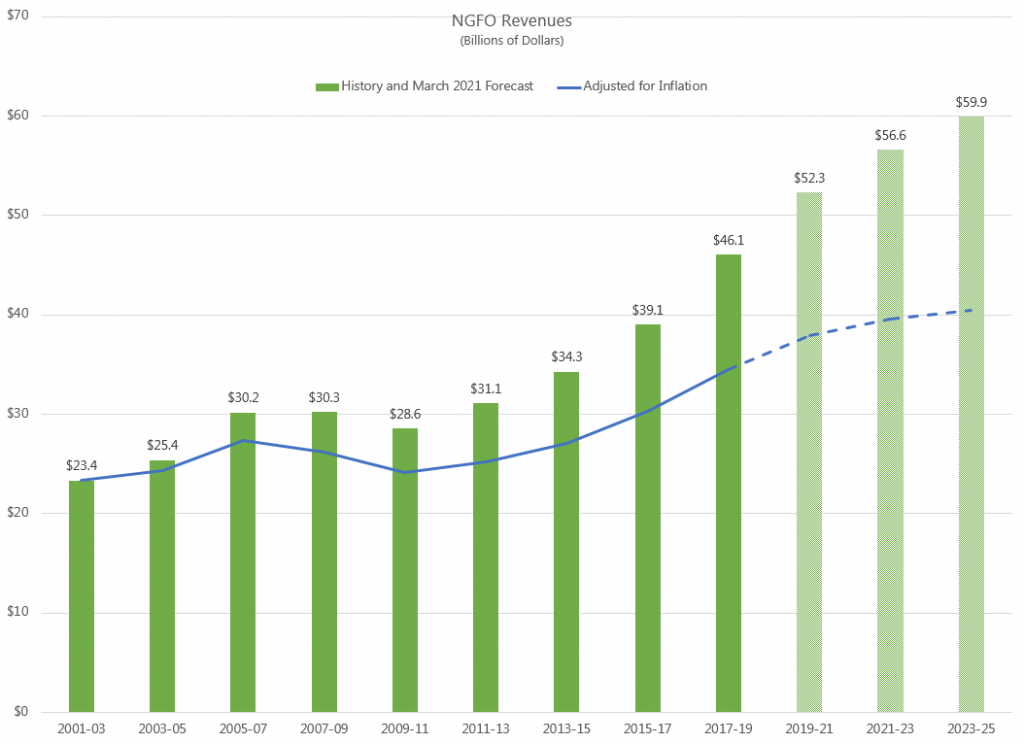11:41 am
April 26, 2021
The Legislature adjourned yesterday, on schedule. Legislators passed a 2021–23 operating budget that appropriates $59.193 billion from funds subject to the outlook.
The Seattle Times reports, “Democratic budget writers hailed the spending plan as a bold investment that will pay dividends. They said they don’t want to repeat the steep and counterproductive spending reductions that followed the Great Recession a decade ago.”
Indeed, spending cuts weren’t necessary this time around because current revenues are expected to keep growing (even without the new capital gains tax). In the Great Recession, on the other hand, revenues actually declined. Spending reductions (in addition to tax increases and federal funding) were required to balance the budget following the Great Recession’s revenue losses. That wasn’t the case this year.

Further, the spending cuts back then could have been smaller, but the state’s rainy day fund (the budget stabilization account, or BSA) was new and had not yet had time to build up a sufficient balance.
Coming into this legislative session, the BSA balance was expected to be historically high; if revenues had declined (as was expected last summer), the BSA would have gone a long way toward protecting programs from spending cuts (and taxpayers from increased taxes).
Although revenues recovered, the budget passed by the Legislature still drains the BSA in 2019–21. The $1.820 billion balance is transferred to the general fund–state (this can be done with a simple majority—instead of a three-fifths majority—because employment growth is forecast to be less than 1% this year). Then, $1 billion is transferred from the general fund to the new “Washington rescue plan transition account.” This account will not be subject to constitutional restrictions.
As the Olympian reports, “On the whole, the new account makes the money easier to access for Democrats in the majority.” The budget states that the account may be used for “responding to the impacts of the COVID-19 pandemic including those related to education, human services, health care, and the economy” and “to continue activities begun with, or augmented with, COVID-19 related federal funding.” However, the Legislature can change those allowable uses. According to the Olympian, “the uses included in the bill language aren’t the fund’s limits, [Rep. Timm] Ormsby confirmed. Lawmakers can tap that money and appropriate it without the ‘encumberments of the budget stabilization account statute,’ he said.”
As we’ve written, Washington has strong budget sustainability rules, and they work when followed. Because of constitutionally-required annual transfers to the BSA, it will automatically build back up to an estimated $1.121 billion by the end of 2023–25.
The BSA balance grew so high because of the mandatory deposits and the constitutional limits on withdrawals. But the limits are not insurmountable: legislators have agreed to make many withdrawals over time (in each biennium except 2011–13), as we showed in this policy brief. By moving reserves to an unrestricted account, as we wrote earlier this month, legislators “are playing a shell game with emergency reserves, which undermines the sustainability of the budget.”

Tags: 2019-21 , 2021-23
